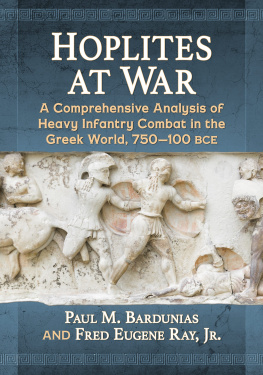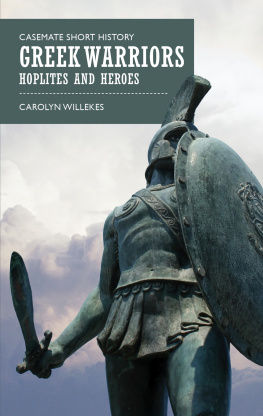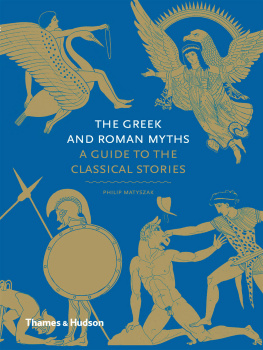
Hoplites at War
A Comprehensive Analysis of Heavy Infantry Combat in the Greek World, 750100BCE
PAUL M. BARDUNIAS and
FRED EUGENE RAY, JR.

McFarland & Company, Inc., Publishers
Jefferson, North Carolina
LIBRARY OF CONGRESS CATALOGUING DATA ARE AVAILABLE
BRITISH LIBRARY CATALOGUING DATA ARE AVAILABLE
e-ISBN: 978-1-4766-2636-9
2016 Paul Michael Bardunias and Fred Eugene Ray, Jr. All rights reserved
No part of this book may be reproduced or transmitted in any form or by any means, electronic or mechanical, including photocopying or recording, or by any information storage and retrieval system, without permission in writing from the publisher.
Front cover image of a statue from Delphi, Greece 2016 TPopova/iStock
McFarland & Company, Inc., Publishers
Box 611, Jefferson, North Carolina 28640
www.mcfarlandpub.com
For my father, Peter P. M. Bardunias,
who raised a boy on Spartan tales and George Greenberg,
the first engineer to understand the dome in the shield
Preface
This book presents a broad study of warfare in the ancient world, as fought by the heavily equipped Grecian spearmen known as hoplitesthe arbiters of conflicts that framed the history of the western world. Though it has been some 2500 years since they dominated the battlefield, these iconic warriors continue to fascinate us today, sparking the imagination of a new generation through a wave of popular action films, graphic novels, documentaries and other mass media.
This popularity has been accompanied by the myth-making of a Hollywood version of history that fosters a distorted view of ancient realities, even among respected historians. Those better versed in the military field have struggled to address this; these efforts have, however, fallen short due to a tendency toward narrow, specialized studies, generally confined to publications not accessed by non-academic readers.
In this book, we make use of traditional sources, but combine these with cutting-edge (apt for a book on warfare!) science to break through an impasse of thought that has held back the study of Greek military affairs for decades. This study draws upon geology and related aspects of known battlefields, the physics of weapons design, and a modern understanding of how order emerges from chaos in crowds of humans to reconstruct ancient Greek warfare, with a focus on fighting methodology and the combat gear. We hope the result provides a comprehensive source on hoplite warfare that will advance key debates for modern scholars, while entertaining the general reader.
As practicing professionals in the physical sciences of behavioral biology and geology, we have both published books and articles based on our respective scientific disciplines and our mutual life-long interest in ancient Greek warfare. Our style here draws upon that experience, but is also informed by those ancient treatises on warfare and history known as Tactica. Writings by men like Aeneas Tacticus and Xenophon brought readers into the action through tales of combat and of the feats and foibles of famous generals. In the spirit of these works, each of the following chapters opens with a detailed account of a renowned battle told from the viewpoint of an ancient commander facing challenges related to the subject matter.
A famed expert on ancient Greek military history once said that only an unusually arrogant scholar could claim to know exactly what kind of thing went on in a hoplite battle. His words are not to be taken lightly, and we make no claim that what we present here is undisputed truth; rather, it is an assessment of what we firmly believe to be most probable based on all the evidence at hand. And in light of the sparseness and frequent ambiguity of our surviving ancient literary and archaeological sources, the process necessarily entails a good deal of speculation. However, we hope that by attempting to reconcile ancient data with the most apt historical analogs and the best modern experimental studies, that this vital guesswork is as informed as possible.
All ancient and modern literary sources are referenced in the endnotes section by chapter. Transliteration of the Greek alphabet has always been difficult. A common approach, the one taken here, is to use Romanized or Anglicized versions of Greek words wherever they are thought to be more familiar to readers of English. All dates cited are BCE unless otherwise specified. Maps, diagrams and other illustrations are embedded throughout near the relevant text.
We would like to thank all those colleagues who have shared information and assisted us over the years. These include fellow searchers after ancient knowledge like Paul McDonnell-Staff, Michael Park, Dan Powers, James Sulzen, Stefanos Skarmintzos, Patrick Waterson, Ruben Post, Barry Jacobsen, Josho Brouwers, and Jasper Oorthus, as well as Joan Huckaby, whose drafting skills have considerably enhanced some of the illustrations herein. We thank all those who don the panoply and show what hoplites were capable of, especially Giannis Kadoglou, Christian G. Cameron, Jeffrey Hildebrandt, Craig Sitch, Sean Manning, Didier Froesel, Emmanuel Fourre, Kevin Astic, Chris Verwijmeren, Ashley Holt, John Conyard, Alan Rowell, Anthony Haegeman, Johan Waroux, Giorgios Kafetzis, Kostas Dimitriadis, Marco Giordani, Sean Campana, all of the loyal Plataeans, and those who shared in the Marathon Archeon Dromena of 2015. These good folk are innocent of any factual errors or inaccuracies that might reside within the following pagesthe authors alone are responsible for thoseand must be credited with doing their level best to keep us on the path toward likely truth.
Introduction
Coming to prominence around 750 BCE, the Greek hoplite was for a period of some 400 years the premier fighting soldier of Western civilization. And he remained a valued element of that worlds war-making for another quarter century or so thereafter. It was an unprecedented span of utility that gave him lasting fame. Indeed, even today in our age of computerized, high-tech weaponry, the venerable image of the bronze-helmeted soldier with distinctive shield and spear remains an exemplar of a true warrior.
Yet, much of what we know (or think we know) about these men runs the gamut from frustratingly vague to outright wrong. Very little hard data has survived over the better than two millennia since the last actual practitioner of hoplite warfare walked the earth. As a result, our view of it has been distorted by popular conceptions of the military cultures of intervening eras, as well as by romantic (and false) images in works of art. This has obscured the true nature of hoplite battle, subjecting its wider appreciation and even academic study to misconceptions, often passionately held. Still, like a cold case crime scene, enough clues linger that we can reasonably hope to reconstruct a vision of the hoplite that is much closer to his reality.
This begins with recognition that Greek hoplites were not the idealized figures portrayed in stone and bronze statuary and fanciful artworks of later centuries (including films of our own age), or as glorified in verse and prose from ancient to modern. They were human beings, subject to the same limitations of technology, dynamics of societal interaction in group efforts, and physical/psychological attributes that have influenced our species throughout history. We can thus learn a great deal about the realities of hoplite warfare by examining weapons, armor, and other items from archaeological sites or as depicted in contemporary artworks. Measuring and testing accurate reproductions of these tools of war allow us to discover how they most probably worked as independent devices. It can also demonstrate the most likely manner they were integrated into a comprehensive combat system.
Next page









